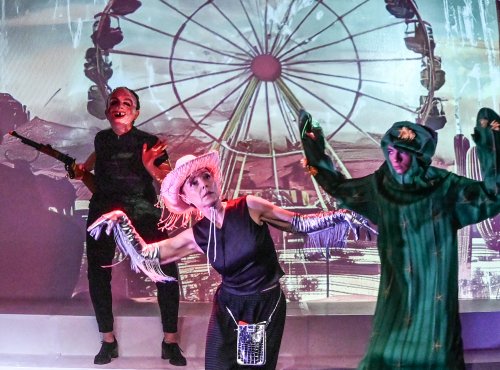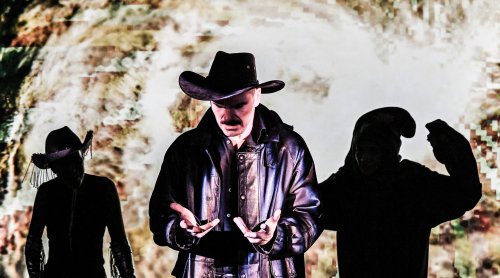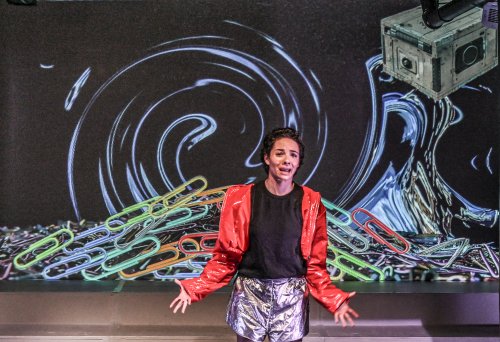In the Common Hour
A play of six stories about an other-dimensional place on the edge of reality inspired by the work of Italo Calvino.

Justin Ivan Brown, Lisa Giobbi and Theodore Bouloukos in a scene from Marie Glancy O’Shea’s “In the Common Hour” at the New Stage Performance Space (Photo credit: Lee Wexler | Images for Imagination)
[avatar user=”Scotty Bennett” size=”96″ align=”left”] Scotty Bennett, Critic[/avatar]
There is a place somewhere, here or there, where moments of time intersect smoothly, easily, fluidly, or in rough, difficult, inflexible ways. It imparts a mark on consciousness, opening a web of possible meanings. It may be in a mountain meadow, on a city street, behind a closed door, or in a motel on a highway lost in the mists of time.
In the Common Hour is a play with text by Marie Glancy O’Shea inspired by the writings of Italian author Italo Calvino of six stories about an other-dimensional place on the edge of reality. A dream world filled with the consequences of people lost in the projections of their being, unsure of what the next moment holds for them. It is a story, or more realistically, a series of episodes, exploring the liminal space created by dreams and hallucinations. The stories bring to mind the speculative and absurdist work by Rod Serling, Ursula Le Guin, and Philip K. Dick, among others.
Conceiver/director Ildiko Nemeth’s work is always worth experiencing. She is adept at giving structure and style to edgy, multimedia, avant-garde stories that are often idiosyncratic and abstract. In this play, she guides an ensemble of players at different skill levels and styles into a cohesive whole who portray a range of characters through six dream sequences. It is not a typical piece of dramatic theater but an example of experimental, multimedia, and avant-garde theater. If you are someone who likes theater in all its forms, then you should see this show.

Gina Bonati, Lisa Giobbi and Lexa Infante in a scene from Marie Glancy O’Shea’s “In the Common Hour” at the New Stage Performance Space (Photo credit: Lee Wexler | Images for Imagination)
The play is set in a motel somewhere along legendary Route 66. A group of travelers gather there as night falls. This particular motel is somewhat different from what one would expect to be typical of such a place. It is a portal that opens to the psychological liminality of anyone who visits, revealing those things that linger at the edge of one’s perception, allowing the individual to confront or retreat from what is being shown.
The show opens with a projection of a stretch of highway along a desolate-looking landscape, slowly changing to the dingy interior of a motel office and then into a cavernous space depicting a bar with a stage. A voiceover prologue guides us through these images, much like Rod Serling’s openings to Twilight Zone. It is an effective technique for establishing a feeling of eeriness and disconnect for the place that has been entered.
VO:
“Within, a space opens up – cavernous. In the middle, the magnetic singer. Her haunting ballad, transfixing – in a language you don’t recognize. Her audience is elegant, yet the room holds a feeling of disorder, the unstable energy of a place where people unknown to each other drift into proximity for one night, and the rules of propriety loosen their hold.”

Lisa Giobbi, Justin Ivan Brown and Lexa Infante in a scene from Marie Glancy O’Shea’s “In the Common Hour” at the New Stage Performance Space (Photo credit: Lee Wexler | Images for Imagination)
The projection changes to what looks like a cavern, and so begins the first of six dream sequences that reveal the inner struggles of different characters. Each dream sequence is presented as a series of interactions that seem connected but may not be, effectively evoking a sense of what dreams are like in the “real” world.
The first dream follows a young woman clutching a cloth-covered frame covering a painting of some significance to her. As the sequence progresses, the setting transitions from her with a solitary figure to a formal cocktail party to an art auction where the picture she has been carrying will be sold. Throughout this sequence, there are cross conversations that seem unrelated to the young woman, and then back to her being the center of attention. In the end, there is no one left in the space but her.
Each dream sequence is accompanied by upstage projections related to the depicted story. The images are only sometimes straightforward, keeping with the expressed dream-like state. Each story is distinctive and conveys the jumble of memories being realized in a narrative that the dreamer may or may not understand. There is an internal consistency between the meaning of each story and its protagonist, regardless of the seeming inconsistencies of the events within each.

Lisa Giobbi, Justin Ivan Brown and Lexa Infante in a scene from Marie Glancy O’Shea’s “In the Common Hour” at the New Stage Performance Space (Photo credit: Lee Wexler | Images for Imagination)
The young woman and the meaning of the painting she carries. A biker in the second dream and his struggle to understand his father’s impact on his life choices. In the third, a gunslinger, riven by his fear of being torn apart by a storm of meaninglessness brought on by years of solitude. A boy escaping greed and evil in the world stumbles upon a witch’s house deep in a forest and brings the things from which he is trying to escape. Next comes an artist trapped in a maze confronting the Beast of her creativity and the deceitful Nymph of her understanding, each pulling at her as if representing truth as she searches for a way out. The last story concerns a chess king confronting the reality of being on the losing side, discovering that all the pieces he counted on to support him were disappearing because he failed to support their existence.
The cast includes Gina Bonati, Theodore Bouloukos, Lisa Giobbi, Markus Hirnigel, Justin Ivan Brown, Alexis Field, Lexa Infante and Palenque Doddington who collaborated on this piece. They do a credible job presenting a diversity of characters in six distinctly different stories. Depending on the characters they are attempting, there is a mixture of solid and average performances, mainly with the minor characters. An actor may not comfortably fit a role in one story but excels with a completely different character in another story. The main characters are solidly portrayed in each episode.
The video design by Hao Bai, with multiple projections in each story, added definition to aspects of the story without being a distraction. The projections included original artwork by Nonoka Sipos Judit, Nan Milkxu and Chris Sharp. Federico Restrepo’s lighting design is a critical ingredient in the theater’s limited performance space. Sound design is an essential element in the telling of these tales, and Patkos Attila’s work is solid and includes original music by Kris Force. Danielle Aziza’s costume design involves various types and styles for the different story elements. Lisa Giobbi’s choreography is an integral component of the show and works well.
In the Common Hour (through May 4, 2024)
The New Stage Theatre Company
New Stage Performance Space, 36 West 106th Street (basement), in Manhattan
For tickets, call: visit: https://app.promotix.com/events/details/In-Common-Hour-tickets?referrer=event
Running time: 75 minutes without an intermission






Leave a comment